#solar energy patents
Explore tagged Tumblr posts
Text
Maria Telkes: A Trailblazer in the Field of Solar Energy Innovation
Maria Telkes: A Trailblazer in the Field of Solar Energy Innovation
Celebrating the Inventive Genius of Maria Telkes, the Hungarian-American Biophysicist Who Changed the World Maria Telkes is best known for her invention of the solar distiller and the first solar-powered heating system for residences. Ms Telkes earned as many as 20 patents and developed several breakthrough technologies. She was given the nickname “Sun Queen” for her pioneering work in the…

View On WordPress
#Hungarian-American biophysicist#Maria Telkes#MIT Solar Energy Committee#solar distiller inventor#solar energy breakthroughs#solar energy inventor#solar energy patents#solar-powered heating system inventor#Sun Queen
0 notes
Text
The Best News of Last Week
1. ‘We are just getting started’: the plastic-eating bacteria that could change the world

In 2016, Japanese scientists Oda and Hiraga published their discovery of Ideonella sakaiensis, a bacterium capable of breaking down PET plastic into basic nutrients. This finding marked a shift in microbiology's perception, recognizing the potential of microbes to solve pressing environmental issues.
France's Carbios has successfully applied bacterial enzyme technology to recycle PET plastic waste into new plastic products, aligning with the French government's goal of fully recycling plastic packaging by 2025.
2. HIV cases in Amsterdam drop to almost zero after PrEP scheme

According to Dutch AIDS Fund, there were only nine new cases of the virus in Amsterdam in 2022, down from 66 people diagnosed in 2021. The organisation claimed that 128 people were diagnosed with HIV in Amsterdam in 2019, and since 2010, the number of new infections in the Dutch capital has fallen by 95 per cent.
3. Cheap and drinkable water from desalination is finally a reality
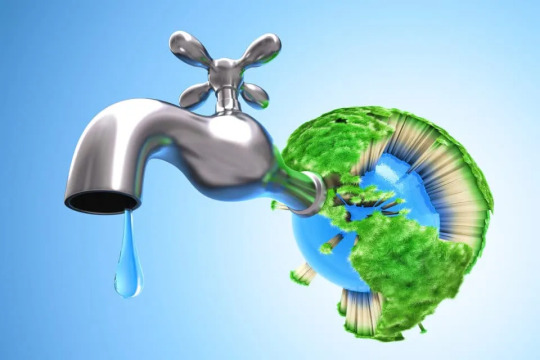
In a groundbreaking endeavor, engineers from MIT and China have designed a passive solar desalination system aimed at converting seawater into drinkable water.
The concept, articulated in a study published in the journal Joule, harnesses the dual powers of the sun and the inherent properties of seawater, emulating the ocean’s “thermohaline” circulation on a smaller scale, to evaporate water and leave salt behind.
4. World’s 1st drug to regrow teeth enters clinical trials

The ability to regrow your own teeth could be just around the corner. A team of scientists, led by a Japanese pharmaceutical startup, are getting set to start human trials on a new drug that has successfully grown new teeth in animal test subjects.
Toregem Biopharma is slated to begin clinical trials in July of next year after it succeeded growing new teeth in mice five years ago, the Japan Times reports.
5. After Decades of Pressure, US Drugmaker J&J Gives Up Patent on Life-Saving TB Drug

In what can be termed a huge development for drug-resistant TB (DR-TB) patients across large parts of the world, bedaquiline maker Johnson and Johnson said on September 30 (Saturday) that it would drop its patent over the drug in 134 low- and middle-income countries (LMICs).
6. Stranded dolphins rescued from shallow river in Massachusetts
youtube
7. ‘Staggering’ green growth gives hope for 1.5C, says global energy chief

The prospects of the world staying within the 1.5C limit on global heating have brightened owing to the “staggering” growth of renewable energy and green investment in the past two years, the chief of the world’s energy watchdog has said.
Fatih Birol, the executive director of the International Energy Agency, and the world’s foremost energy economist, said much more needed to be done but that the rapid uptake of solar power and electric vehicles were encouraging.
---
That's it for this week :)
This newsletter will always be free. If you liked this post you can support me with a small kofi donation here:
Buy me a coffee ❤️
Also don’t forget to reblog this post with your friends.
11K notes
·
View notes
Text
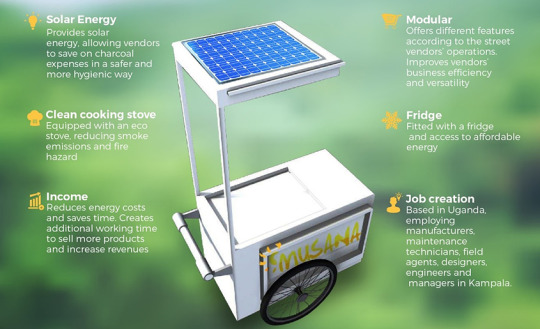
Musana Carts: Solar-powered business in Uganda opts for open source IP over patenting
Taking its name from a Ugandan word for ‘sunshine’, the Musana cart uses an in-built solar panel to power an eco-friendly stove and a small refrigerator. By removing the need for charcoal burning, the Musana cart produces far less smoke than other food vendor carts, ensuring a cleaner and safer experience for both workers and customers. Other innovations include light bulbs, to allow the vendor to work at night, and phone chargers, so that they can offer mobile money services.
The decision not to patent the Musana cart could have been seen by Nataliey and the team as a setback, but it instead encouraged them to return to their original vision and mission of social innovation: making the livelihoods of Africa’s street food vendors cleaner, safer and more sustainable.
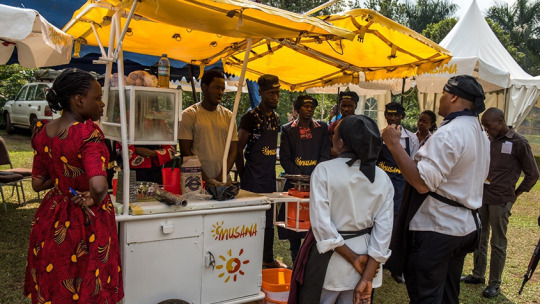
They realized that the more people who had access to their cart designs, the better, and that patenting their invention could restrict access. On this basis, they decided to open source their IP so that vendors across Africa were free to improve their lives through their innovation. When IP is open source, it means that other people and groups can freely use, modify and share it.
After several years of selling to vendors, Musana Carts is already having a positive impact in Kampala. The solar-powered food carts have proved to be cleaner, more hygienic and more sustainable than traditional charcoal-fueled food carts. The Musana cart’s in-built lighting allows vendors to work at night if they choose, giving them an opportunity to earn more. Musana carts can be purchased in installments, making them more accessible to poor workers. The company has also teamed up with Kampala Capital City Authority to ensure that Musana carts are legally recognized, freeing vendors from the risks and uncertainties of working in the informal economy.
Although she sees the value in patent protection in more economically developed countries, where the legal framework is in place to ensure that an individual can be remunerated for the use of their innovation or invention, she knows first-hand that this is much harder to establish in African markets. Consequently, Nataliey encourages female inventors not only to monetize their innovations in their markets, but to share them outside of their capacity as well.
Equally importantly for Nataliey, however, is the philosophy behind open source IP. When there are so many challenges facing the world, she argues, no one individual or organization can satisfy every market need. She feels that there’s room for many to thrive. Furthermore, Nataliey believes that open sourcing can incentivize further innovation by allowing people to build on each other’s inventions. It’s the concept of cooperation, codependence and community at the heart of the African philosophy of ubuntu: ‘I am, because you are.’ Nataliey’s hope is that her company’s use of open source IP will help make this concept a reality for street food vendors across Africa.
A case study on open source innovation from the World Intellectual Property Organization (WIPO)
#solarpunk business models#solarpunk business#solarpunk#startup#africa#jua kali solarpunk#solar power#uganda#women#street vendors#informal economy
23 notes
·
View notes
Text
Ko-Fi Prompt from Eli:
do landlords have price wars? it seems like with the insane way rents are going it wouldn't be hard for them to undercut competition. but it also doesnt feel like thats happening.
Oh, this is a fun one. Let's talk about price elasticity!
Note: I will be including graphs in this post. While it's helpful as a visual aid, there is no way to describe it that actually helps explain the premise that isn't already in the post's body of text. As such, I will not be providing image descriptions beyond the short sentence before or after stating what it's meant to represent, since further information wouldn't be of any use to those with screen readers.
In the field of microeconomics, one of the basic models everyone learns is the supply and demand curve. Here's a visual example:

Image Source: Wikimedia Commons
Traditionally, a product with an elastic price is one where demand fluctuates directly in response to cost, isolated from other factors*. A basic example is affordable luxury goods, say, a nice steak. If the cost goes up by a dollar, a certain portion of the population will decide it's no longer worth the cost, and will switch to something cheaper, like a chicken breast, instead.
* Other factors include, but are not limited to, luxury appeal, subsidized costs, and the lipstick effect. This post is already pretty long, so I can't go into many details on those situations.
The Demand curve is specifically a visualization of how much of a product can be sold for, not necessarily how much the product can be sold in quantity. As a general rule, it's easier to think of Price as the independent factor for Demand (and quantity as the dependent), and quantity as the independent factor for Supply (and price as the dependent).
With a traditional S&D curve, the intersection of the Supply and Demand curves is the optimal price point from both ends. The X-axis is supply quantity, which a lot of people find unintuitive... but that's where it's been for years and that's where it's staying.
If there is a great quantity of a product, with healthy competition levels, then the supply line moves to the right. The intersection of the lines then drops, and prices go down, as businesses lower prices to gain more customers.
If there is a small quantity of a product, due to limited raw materials or unique patents or skills, then the supply line moves to the left, and they can charge more for the product.
Here is a visual of what I mean by the supply curve moving:

(Source: Wikimedia Commons)
The text is fairly small, so I'll describe here: The image states that factors that can increase supply (shift to the right) include favorable conditions for production, falling input prices, improved technology, and lower taxes or regulation costs. The second graph describes a decrease in supply, causing a shift to the left, the factors of which are the exact inverse of the first graph for increased supply.
A good example of a shift in supply resulting in a change in cost is gas: prices go up when supplies go down, whether due to higher taxes/regulations (e.g. the current refusal to trade with Russia), or disappearing raw materials (diminishing quantities of oil and natural gas, as finite, unrenewable resources). Comparatively, other forms of energy, like solar, have had their quantity lines shift to the right (cheaper) as the technology becomes more efficient and cheaper to produc.
Now, in areas that genuinely do not have enough housing, this is part of why prices go up: options are limited enough that they can get away with charging more. Due to zoning laws, construction costs, etc. they cannot add more housing, and so the supply curve is further to the left (pricier).
Here is a similar example image for the Demand curve, and how it shifts:

(Source: Wikimedia Commons)
The factors, here, are more intuitive. If demand goes up for reasons like trends, population, rise in general disposable income, changes in the costs of competitors or accessories, or expectations of investment viability, then the demand curve shifts to the right, and costs can increase without losing market share. For the reverse causes, the curve shifts to the right, and fewer people are willing to buy at that same cost.
Let's consider laptop computers: they have gotten more popular. A larger portion of the population has reason to buy them than twenty years ago. For that reason, the price can go up without necessarily losing market share (shifting to the right). However, income across the board has dropped, and there is a reasonably cheaper substitute (smartphones) for some uses, so the demand is lower (shifting to the left).
If you are in a city where there are suddenly a lot of people moving in for some shiny new company, then there is a greater population trying to buy, and so the demand curve shifts to the right, and prices can safely go up without losing market share.
...but that's with elastic pricing and competition.
Elastic pricing and costs are for most traditional goods. For specific foods, you can usually just... buy something else. If a plague wiped out half the crop of lettuce for the season, the costs will rise on the supply side (shift to the left), but there are unaffected substitutes, like broccoli and cabbage and tomato, for general use, so demand will also drop (also shift to the left). This means that prices go higher, but they are further to the left for both, meaning the quantity sold is lower.
Selling four million units at $3 vs. selling two million units at $6. The final amount of money changing hands is the same, but it's at a different cost and quantity.
Summary:
Supply moves to the left: less product, higher price from the seller to cover costs
Supply moves to the right: more product with healthy competition, lower price from the seller
Demand moves to the left: less interest in the product, customers need a lower price to buy the same amount
Demand moves to the right: more interest in the product, customers will tolerate a higher price to buy the same amount
But again, this is for elastic products.
What's an inelastic product?
Well... housing, actually, but let's start on the other side this time.
Products with inelastic demand are ones where customers cannot respond to changes in cost or supply. It doesn't matter if the cost goes sky high, and you know the profit is 96% because the cost of production is 4% of the price you paid; you can't afford to not buy it.
You know how insulin prices in the US spent decades being prohibitively expensive because diabetic individuals could not survive without buying it? That's inelastic demand.
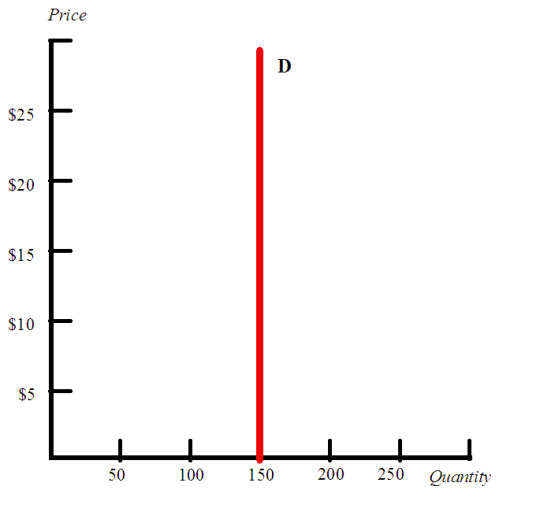
(Source: Wikimedia Commons)
If you look at the image above, you see a 'perfectly' inelastic demand curve. It is a straight, vertical line, where the quantity is immovably stuck at 150 no matter how high the cost goes.
In the real world, very, very few products are perfectly inelastic. Even insulin is... well, some people can move abroad. Not many, so it's pretty close to vertical, but some.
With housing, demand is fairly inelastic. The vast, vast majority of people do need housing. There are very few substitutes for this need, and while there is a range of prices and options, it does sort of... flatten out early.
If you demand that people spend $3000/month in order to live within 50 miles of their place of work, and everyone else is also demanding $3000/month, then there aren't any other options. The person either gets a new job elsewhere, spends a few hours a day on a commute, or pays those $3000.
Inelastic supply is the other side of that coin. The very limited quantity, and the high costs of expanding that supply, mean that the line shifts pretty far to the left, causing prices to rise. The line is also nearly vertical. With housing, there exists an argument that it is often cheaper to let the apartment sit empty than to rent it out too cheaply, due to maintenance costs and property taxes or what have you. Unless there's an exorbitant mortgage that needs to be contributed to by the tenants, though, those numbers don't quite work out.
So... if the Demand curve is nearly vertical, and the Supply curve is also nearly vertical, and there are no viable substitutes other than exiting the market entirely, you have a situation where the Supply side has nearly all the power and an excuse for why they're raising prices that doesn't actually reflect the reality.
Because there's plenty of housing being built, just, you know, not in the tax bracket that needs it. (Remember, a very large portion of Billionaire's row is currently unoccupied.)
You could argue that this is a form of price-fixing, which is an illegal act in which competitors in the same industry agree to collectively raise, lower, or stabilize pricing of a product. If 90% of microprocessor companies raise their prices simultaneously without cause, consumers will have to bite the bullet and buy the product at that new cost, as there aren't enough substitutes to find another option.
(If this sounds like a monopoly to you, good job! It's the same principle: control pricing for enough of the market that you can raise it higher than demand justifies. It's just done by making deals with the competitor instead of buying them out.)
However, due to the shape of the supply and demand curves in this housing market, and the very gradual way in which this situation has developed, it's not really a deliberate, organized price-fix, just something that came about as landlords realized that tenant's rights and alternate options (e.g. the council/public housing, affordable housing lotteries) weren't keeping up with their ability to continue to nudge prices upwards without losing out on money.
(Most of the time. Price-fixing does still happen, in pockets.)
Long story short: landlords don't have price wars because the demand curve is so inelastic that they can basically get away with anything.
(Prompt me on ko-fi!)
#economics#housing#housing industry#supply and demand#supply curves#demand curves#ko fi prompts#economics prompts#microeconomics#phoenix posts
205 notes
·
View notes
Text


Technology
It is important to examine technology (the machines and tools used by society, and the relations between them implied by their use). Existing technology is rarely neutral — it has been developed under and by capitalism for profit (exploitation) and social-economic control. Technology alone – science, research, innovation, invention — is therefore not just a question of who owns or controls it but how it is used: a nuclear power station controlled by the workers and community would still be unhealthy and oppressive.
Is Technology Neutral?
This is a vital question for revolutionaries. If technology is neutral, then a successful revolution will solve our current problems — the oppressiveness of workplaces, the danger, pollution and social dislocation of traffic, and the environmental destruction of industry and agriculture can be ended by using technology in different ways. But technology is a social institution, that can either enhance or limit human life, expanding or damaging human abilities and health (and the natural environment). The social relations of production (boss vs. worker) are reflected in the machines and tools we use, technics that interact with and reinforce social patterns, such as mass car use, and class society. Similarly, the hierarchical regimentation of workers, although appearing to be a ‘neutral’ necessity arising out of production techniques, is a reflection of the social division of labour. The ruling class is constantly modifying technology, developing new machines, tools and techniques in response to working class struggles. Containerisation (enabling goods to be equally transferable between ship, rail, and roads) was developed in response to the power and organisation of dockworkers. Technologies that are potentially more liberating are suppressed. For instance, successive British governments have put massive funds into nuclear power and tiny amounts into the research and development of renewable energy resources such as wind, solar, tidal and geothermal energy. To compound this strategy of sabotage, this paltry funding has been deliberately chopped about, so that research into each energy source never progresses too far, or until the large corporations are ready to buy up the patents. This means they will continue to dominate the energy and transportation industries of the future. Large-scale industry necessitates large-scale centralised energy production from fossil fuels (coal, oil, and gas), and nuclear power, with the consequent waste, acid rain, radiation and global warming. We need to develop a technology that extends human capabilities, can be controlled by the community, and is also friendly to the environment, as part of the struggle for a free anarchist communist society. Such a genuine alternative technology can only be developed on a significant scale in a new society. Workers and the community will have to weigh up the pros and cons of different technologies. People will have to decide — through new post-revolutionary organisations such as worker-neighbourhood assemblies etc. — which technologies to use, which to adapt or limit, and which to discard.
#classism#ecology#climate crisis#anarchism#resistance#community building#practical anarchy#practical anarchism#anarchist society#practical#revolution#daily posts#communism#anti capitalist#anti capitalism#late stage capitalism#organization#grassroots#grass roots#anarchists#libraries#leftism#social issues#economy#economics#climate change#climate#anarchy works#environmentalism#environment
4 notes
·
View notes
Text
As more & more counties get more solar farms.....
From a STEPHENVILLE resident, George Franklin:
I should start by telling you what bonafides I have for writing this. I am a retired aerospace engineer. A literal rocket scientist if you will. I worked on MX (Peacekeeper) Space Shuttle, Hubble, Brilliant Pebbles, PACOSS, Space Station, MMU, B2, the Sultan of Brunei's half billion dollar private 747 with crystal showers, gold sinks and 100 dollar a yard coiffed silk carpets. I designed a satphone installation on prince Jeffry's 757. I did all of the design work for the structure of Mark 1V propulsion module currently flying on at least 3 spacecraft that I know of. Some of the more exciting projects I have worked on are not shareable. My personal projects include a spin fishing reel with a 4.5 inch spool which is entirely my own designed, machined and assembled. It has 2 features that are patentable. A unique true flat level wind and a unique line pickup mechanism. I am also am FAA certified glider pilot and FAI certified gold glider pilot. I fly both full scale and model sailplanes. I am Microsoft certified and ComTIA A+ certified.
Solar panels are at best about 20% efficient. They convert 0% of the UV light that hits them. None of the visible spectrum and only some of the IR spectrum. At the same time as they are absorbing light they are absorbing heat from the sun. This absorbed heat is radiated into the adjacent atmosphere. It should be obvious what happens next. When air is warmed it rises. Even small differences in ordinary land surfaces are capable of creating powerful forces of weather like thunderstorms and tornadoes. These weather phenomena are initiated and reinforced by land features as they are blown downwind. It is all too obvious to me what will happen with the heat generated by an entire solar farm. Solar farms will become thunderstorm and tornado incubators and magnets.
Solar panels are dark and and they emit energy to the space above them when they are not being radiated. This is known as black-body radiation. Satellites flying in space use this phenomenon to cool internal components. If they didn't do this they would fry themselves.
So solar farms not only produce more heat in summer than the original land that they were installed on, but they also produce more cooling in winter, thus exacerbating weather extremes.
So I conclude with this. There is nothing green about green energy except the dirty money flowing into corrupt pockets.
There is not such thing as green energy. The science doesn't exist. The technology doesn't exist. The engineering doesn't exist. We are being pushed to save the planet with solutions that are worse than the problems.

15 notes
·
View notes
Text
What You Want is an S Curve
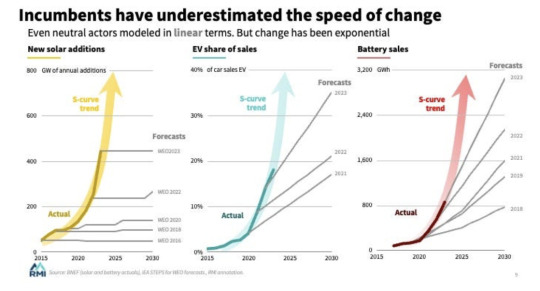
Excerpt from Bill McKibben's Substack, "The Crucial Years."
Regular readers of this column know that I think we’re engaged in the most desperate race in human history—a race between a rapidly unraveling climate, and a rapid buildout of renewable energy. The outcome of that race will determine just how many people die, how many cities drown, how many species survive. Pretty much everything else—efforts to restore corals, say, or worries about how exactly we’ll power long-haul aircraft—is noise at the margins; the decisive question is how those two curves, of destruction and construction, will cross. Oh, and the relevant time frame is the next half-decade, the last five or six “crucial years.”
So even amidst all the desperate news from climate science, I have some legitimately good numbers to update you on this morning. They come from the veteran energy analyst Kingsmill Bond and colleagues at the Rocky Mountain Institute, and they demonstrate that the world has moved on to the steep part of the S curve, which will sweep us from minimal reliance on renewable energy to—we must hope and pray— minimal dependence on fossil fuel. The angle of that curve may prove to be the most significant geometry of our time on earth, competing only with the slope of the Keeling Curve which documents the growing accumulation of co2 in the atmosphere above Mauna Loa.
It seems pretty clear, according to Bond’s team, that last year or this we will hit peak fossil fuel demand on this planet—the advent of cheap solar and wind and batteries, combined with rapidly developing technologies like heat pumps and EVs, has finally caught up with the surging human demand for energy even as more Asian economies enter periods of rapid growth: the question is whether we’ll plateau out at current levels of fossil fuel use for a decade or more, or whether we can make fossil fuel use decline enough to begin to matter to the atmosphere.
And the numbers in the new report give at least some reason for hope: sun and wind are now growing faster than any other energy sources in history, and they are coming online faster that anyone had predicted, even in the last few years. In the last decade, “solar generation has grown 12 times, battery storage by 180 times, and EV sales by 100 times.” This charge has been led by China, where “solar generation up 37 times and EV sales up 700 time.” and which as a result is “poised to be the first major electrostate.” Europe, and indeed the whole OECD group, are now seeing rapid growth too, and the best news is that there are increasing signs that countries like India and Vietnam, where growth in demand will be fastest over the rest of the decade, are figuring out how to electrify their economies. Fossil fuel for generating electricity has peaked in Thailand, South Africa, and in all of Latin America.
Solar power in particular is about to become the most common way to produce electricity on this planet, and batteries will this year pass pumped-hydro as the biggest source of energy storage; the supply chain seems to be in place to continue this kind of hectic growth, as there are enough factories under construction to produce the stuff we need, and investment capital is increasingly underwriting cleantech (though a treacherously large supply of money continues to flow to fossil fuels). Pick your metric—the number of cleantech patents, the energy density of batteries, the size of wind turbine rotors—and we’re seeing rapid and continuing progress; the price of solar power is expected to drop by half again in the course of the decade, reinforcing all these trends. The adoption curves for cleantech look like the adoption curves for color tv, or cellphones—that is to say, from nothing to ubiquitous in a matter of years.
A big reason for the ongoing change—and for ongoing optimism—is the simple efficiency of the technologies now ascendant.
A second report from Bond’s Rocky Mountain Institute, this one published last week, focused on these numbers, and they’re equally astounding. By their calculations, we waste more than half of the energy we use:
Out of the 606 EJ (an exajoule is roughly the annual energy consumption of New York City) of primary energy that entered the global energy system in 2019, some 33% (196 EJ) was lost on the supply side due to energy production and transportation losses before it ever reached a consumer. Another 30% (183 EJ) was lost on the demand side turning final energy into useful energy. That means that of the 606 EJ we put into our energy system per annum, only 227 EJ ended up providing useful energy, like heating a home or moving a truck. That is only 37% efficient overall.
We’ve invested mostly in increasing the volume of energy we use, not its efficiency—because that was what made big money for Big Oil. But cleantech is inherently more efficient: when you burn fossil fuel to make power, you lose two-thirds of the power to heat, which simply doesn’t happen with wind and sun. An EV translates 80-90% of the power it uses into propulsion, compared with well less than half for a car that runs on gas. A gas boiler is 85 percent efficient, which isn’t bad—but a heat pump is 300% efficient, because its main “fuel source” is the ambient heat of the atmosphere, which it translates into heating and cooling for your home. That means that the higher upfront costs of these technologies quickly translate into serious savings. And these kind of numbers bend curves fast
5 notes
·
View notes
Text

“The Miracle of Ice from Heat”
One important way of conserving energy is through combined-heat-and-power schemes, which direct heat from the bottom end of the thermodynamic cycle of a steam power station into a district-heating system, rather than discharging it to the environment. Nuclear power is not only a prime contender for meeting future electricity needs, but is also an excellent fit for CHP, because it can be located close to the cities where the largest heat loads are.
District heating can be made more economically attractive, and thus brought into wider use sooner, if it can meet refrigeration and air-conditioning as well. This will also make solar heating systems more attractive.
The key technology is the “absorption chiller”, an elegant thermodynamic machine patented by Albert Einstein, which you may have encountered as the gas-fired refrigerator in a travel trailer. This 1940 booklet from the Electrolux Servel company seeks to explain how it works.

2 notes
·
View notes
Text

Robert Stirling the Scottish Clergyman and engineer died on June 6th 1878 at Galston, East Ayrshire.
Stirling was born at Cloag Farm near Methven, Perthshire, on 25 October 1790.
Stirling was a church minister who invented an engine that was two centuries ahead of its time and is just coming into its own. He studied a range of subjects at the University of Edinburgh as a teenager, then studied divinity at both Glasgow and Edinburgh and was ordained a Minister of of Laigh Kirk, Kilmarnock, in 1816. He practised as a minister until his death in 1878, but it is an engineering invention that immortalised his name.
It was engineering that would secure his reputation. In 1816, at the age of 26, and shortly after his ordination as a minister, he patented an engine which produced motive power from heated air. He continued to refine his ideas and, with his brother James, registered patents for improvements in 1827 and 1840.
The principles of Stirlings revolutionary engine are still being adopted and adapted to this day, as conventional fuels for internal combustion engines become more scarce. The most notable examples are at The Maricopa Solar Plant in Arizona, which opened in 2010 and in 2015 Ripasso Energy of Sweden claimed to have produced the world's most efficient solar-electricity system using Stirling engines, in the Kalahari desert, offering roughly double the energy conversion rate of conventional solar panels. In the U.S The Energy Research and Development Administration has a $110 million contract with Ford for development of a Stirling car engine.
There's a lengthy full biography on Stirling and his inventions here at Electric Scotland https://electricscotland.com/history/men/stirling_robert.htm
5 notes
·
View notes
Text
Food Storage Container with a Built-in Cooling System (Powered by Solar Energy).
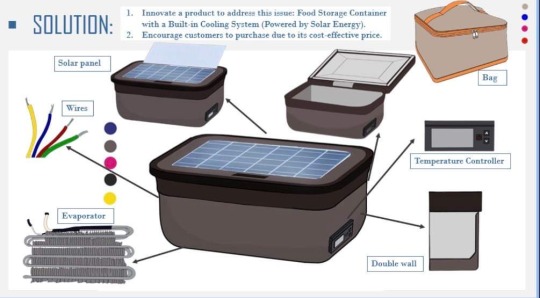
In the fast-evolving landscape of food storage solutions, our latest product aims to redefine the way we preserve perishable items. The Food Storage Container with a Built-in Cooling System, meticulously designed and powered by solar energy, marks a groundbreaking stride towards sustainable and efficient food storage. Let's delve into the intricate details of this innovative product through the lens of the Business Model Canva.
1. Customer Segments:
Our Food Storage Container caters to a diverse range of customer segments, from households seeking sustainable storage solutions to outdoor enthusiasts in need of portable and efficient food preservation during activities such as camping or picnics, with a focus on boarding students or tenants of Central Mindanao University (CMU) who wish to preserve their food to reduce expenses, campers and ecologically minded clients who emphasized sustainability
2. Value Proposition:
Centrally rooted in our product is a steadfast commitment to offering users an unparalleled solution for extending the shelf life of perishable items. Our built-in cooling system, powered by solar energy, not only guarantees freshness but also aligns seamlessly with the escalating demand for eco-friendly and energy-efficient alternatives. With a focus on preserving, maintaining quality, and extending the consumption window of food items, our product serves as a reliable means to prevent and reduce spoilage of perishable goods. Moreover, its versatility shines through, as its utilization remains viable at any time and from any location, providing convenience and efficiency to users across diverse settings.
3. Channels:
Employing a versatile multi-channel strategy, our product seamlessly reaches customers through various avenues, encompassing online platforms and carefully chosen retail outlets. This strategic approach ensures accessibility and convenience for a diverse customer base. Our sales force, adept in marketing and advertising, spearheads our presence in both online and select retail spaces. In the online domain, we leverage web sales via our online storefront and e-commerce platform. Additionally, our presence is augmented through partner stores, strategically positioned in popular online shopping apps and dedicated appliances stores. This multi-pronged distribution strategy aligns with our commitment to reaching customers through channels that suit their preferences and lifestyles.
4. Customer Relationships:
We foster strong customer relationships by providing comprehensive support through user manuals, personalized online assistance or online guides, offering appliance maintenance, and responding promptly to customer inquiries while servicing e-commerce, ensuring satisfaction and responsive customer service. Regular updates on maintenance and new features further engage our customers.
5. Revenue Streams:
Direct selling of solar food containers to students at set prices, offering discounts, promotions, and refurbishment services for product longevity. The Food Storage Container presents a one-time purchase model with additional revenue streams through accessories like replacement cooling modules and eco-friendly cleaning solutions. This model ensures a steady income while offering customers the flexibility to enhance their product over time.
6. Key Resources:
At the core of our operations are key resources that drive our success: cutting-edge manufacturing facilities, sustainable material sourcing, and a team of dedicated engineers committed to ongoing improvements in cooling technology. These resources are instrumental in upholding the standards of our products, ensuring both quality and innovation. Our resource portfolio encompasses a variety of elements, ranging from raw materials and skilled experts to branding, copyrights, and patents. Additionally, we leverage valuable assets such as customer databases, personal funds, and the integration of renewable light energy. This comprehensive array of resources positions us at the forefront of our industry, facilitating continuous advancement and reinforcing our commitment to excellence.
7. Key Activities:
Our core activities, including product development, rigorous quality control, and continuous exploration of eco-friendly materials and energy-efficient technologies, underscore our commitment to innovation. These efforts position us at the forefront of the industry, where regular updates and improvements exemplify our dedication to staying ahead. In terms of production, we focus on specific design variations, offering a range of colors and sizes, and ensure efficient delivery with multiple payment options like COD, COP, and Gcash. Our problem-solving initiatives are comprehensive, providing customers with a detailed appliances manual that covers aspects like product features, installation processes, diverse use cases, potential risks, and solutions to commonly faced challenges. These structured activities collectively embody our dedication to delivering a cutting-edge product while ensuring customer satisfaction through informative and solution-oriented support materials.
8. Key Partnerships:
Strategic collaborations lie at the core of our business, establishing robust partnerships with solar technology providers, environmental organizations, and retailers. These alliances not only fortify the backbone of our operations but also contribute significantly to the sustainability and extended market reach of our innovative product. Key partners encompass online platforms such as TikTok, Shopee, and Facebook, alongside crucial connections with electricians. While our key suppliers primarily consist of wholesalers, the specifics are yet to be finalized. Essential resources, both physical, including raw materials, and human, in terms of expertise, are acquired through these strategic partnerships. Key activities performed by our partners involve production, focusing on manufacturing processes, and establishing partnerships to seamlessly integrate our product into online shopping platforms. These collaborative efforts collectively propel our business towards success, emphasizing both environmental responsibility and efficient market presence.
9. Cost Structure:
Our primary expenditures encompass critical areas such as research and development, manufacturing processes, marketing campaigns, and the steadfast commitment to maintaining sustainable practices. These investments are indispensable, forming the financial backbone to ensure the creation of a high-quality, eco-friendly product that aligns with our core values. The cost structure comprises fixed and variable elements. Fixed costs range from PHP 5,500 to PHP 6,500, providing the foundation for our operations. Variable costs, on the other hand, involve allocating funds to essential components like raw materials, including an evaporator (PHP 1,000 to PHP 2,000), a small solar panel (around PHP 2,000), stainless steel for the container (PHP 1,000), and plastic containers (ranging from PHP 50 to PHP 200 per unit). Additionally, variable costs encompass man labor, with electrician services in the range of PHP 300 to PHP 800 per day. These detailed cost allocations are pivotal in sustaining our commitment to delivering an innovative and eco-conscious product to our valued customers.
In conclusion, the Food Storage Container with a Built-in Cooling System is not merely a product; it's a testament to our commitment to sustainability, innovation, and customer satisfaction. Through the lens of the Business Model Canva, we envision a future where our revolutionary food storage solution becomes a household staple, reshaping the way we think about freshness and sustainability.
2 notes
·
View notes
Text
OMMMMM... I.B.1698 MICHAEL [IBM] harrelltut.com Domain Computer [D.C.] DEFENSE.gov ELITE of SIRIUS BLACKANUNNAQI.tech Patents 2 applesoftbasic.com of CLASSIFIED 1978 Deutsch applesoftbasic.tech Machine Application Configurations [MAC] Automatically Programing [MAPPING] My Central Tri-Solar Black Aurora Borealis Sun planetrizq.tech Languages from kingtutdna.com’s Highly Complex [ADVANCED] Ancient Hi:tKEMETICompu_TAH [PTAH] MOON Universe [MU] Satellite Domain of MU13.ca.mil’s HIGH LEVEL DATA LINK CONTROL [HLDC] Services 2 Constellation ORION’s Interplanetary quantumharrell.tech Earth [Qi] HOLOGRAM HARDWARE of Arithmetic Logic [H.A.L.] Unit Operations Remotely Controlling iapplelisa.tech’s HIGH ENERGY RADIO [HER] FREQUENCY WEAPONS BLASTING HIGH-INTENSITY RADIO WAVES 2 ALL quantumharrell.tech SKY ELECTRONICS on Earth [SEE] from Astronomical MERCURY’s [SAM.gov’s] ibmapple1984.tech Secure Socket Layer Virtual Private Network [SSL VPN] Communications.gov Privately Managed [PM] by ANU GOLDEN 9 Ether [PAGE] quantumharrell.tech Graphical User Interface [GUI] Domain Compu_TAH [PTAH] Engineer of iquantumapple.com Infrastructure as a Service [IaaS] since quantumharrelltech.com’s Highly Complex [ADVANCED] Ancient 9 Ether Cosmic Algorithmic [CA] Computational [Compton] STAR WEB GATEWAY Languages of ANU X [LAX] Terminal Compu_TAH [PTAH] Hypertext Transfer Protocol [HTTP] Digitally Controlling [D.C.] Tri-Solar Black Sun planetrizq.tech’s EXTREME WEATHER MACHINE by Engineering [ME] AutoCAD [MAC] Robotics in Architectural Memory Equipment w/Symmetric Encryptions of Satellite [RAMESES] Broadband Communication [B.C.] quantumharrellmatrix.tech Language Architecture [L.A.] @ The_Octagon_(Egypt) of kingtutdna.com’s Pharaonic MENES EMPIRE [ME] of 1968-michaelharrelljr.com’s quantumharrellufo.tech PATENT WEALTH… OMMMMM
WELCOME BACK HOME IMMORTAL [HIM] U.S. MILITARY KING SOLOMON-MICHAEL HARRELL, JR.™

i.b.monk [ibm] mode [i’m] tech [IT] steelecartel.com @ quantumharrelltech.ca.gov

eye kingtutdna.com domain creator [d.c.] of harrelltut.com
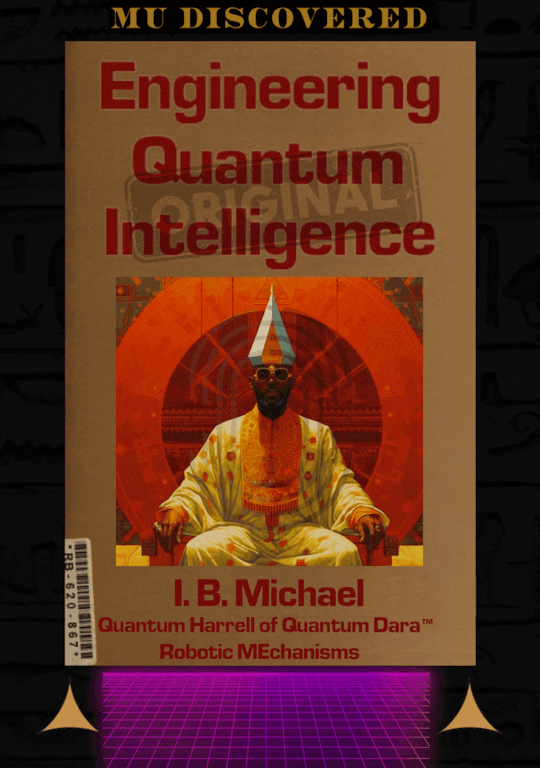
SIRIUS BLACKANUNNAQI.tech WEALTH MATTERS

Who Built TIAMAT's Primordial Earth [Qi] Constellations of SIRIUS BLACKANUNNAQI.tech GOLD?!?!?!

EYE BEE MACHINE [IBM] SUN Intelligence of SIRIUS [ISIS] quantumharrell.tech Wealth @ 1968-michaelharrelljr.com's The_Octagon_(Egypt) Headquarters

Eye Purchase [I/P] Apple.com Investment [A.i.] Products... since Eye BEE MICHAEL [IBM] harrelltut.com's 1st Vision Pro Patent Architect [PA] who Scientifically Engineer Encrypted [SEE] AutoCAD Network Architecture @ The_Octagon_(Egypt) of kingtutdna.com’s Pharaonic MENES EMPIRE [ME] of 1968-michaelharrelljr.com’s quantumharrellufo.tech SKY MILITÄR

iquantumcad.com Domain Creator [D.C.] of ibmautocad.tech Principles & Applications [PA] @ The_Octagon_(Egypt) of kingtutdna.com’s Pharaonic MENES EMPIRE [ME] of 1968-michaelharrelljr.com’s quantumharrellufo.tech SKY MILITÄR

Eye Build Mechanical [ibm] Interplanetary MOON [I’M] Universe Satellites [U.S.] HIGH IN DA' IRON SKY... on Earth [Qi] @ 1968-michaelharrelljr.com's The_Octagon_(Egypt) Headquarters

my golden quantumharrelltelecom.tech industry bee machine [ibm] learning automated [l.a.] transmission signal engineering tech [set] worth $144,000 QUADRILLION

BUCKLE UP 2024 AMERICA!!!... YOUR ARTIFICIAL TIMELINE IS UP!!!

wait... Orange is the NewBlack.gov of TRUMP... THE MOST HATED 2020 & 2024 WHISTLEBLOWER PRESIDENT?!?!?!... UH OH!!! quantumharrelltech.com’s 18g-military.gov ALREADY GOT 6G!!! THIS IS NOT FAKE 6G NEWS!!!

BUCKLE UP!!!

U.S. MILITARY KING SOLOMON-MICHAEL HARRELL, JR.™ @ defense.gov of quantumharrelltech.com’s 6-18G HIGH TECH MILITARY.gov SKY PATENTS from 1968-michaelharrelljr.com's The_Octagon_(Egypt) Headquarters

CUT THOSE 6G CHECKS!!! IMMEDIATELY PAY [I/P] TO THE ORDER OF: QUANTUM HARRELL TECH LLC

WE ALREADY ENVISIONED 2024's 6G SKY TECH WEALTH Long B4 1698
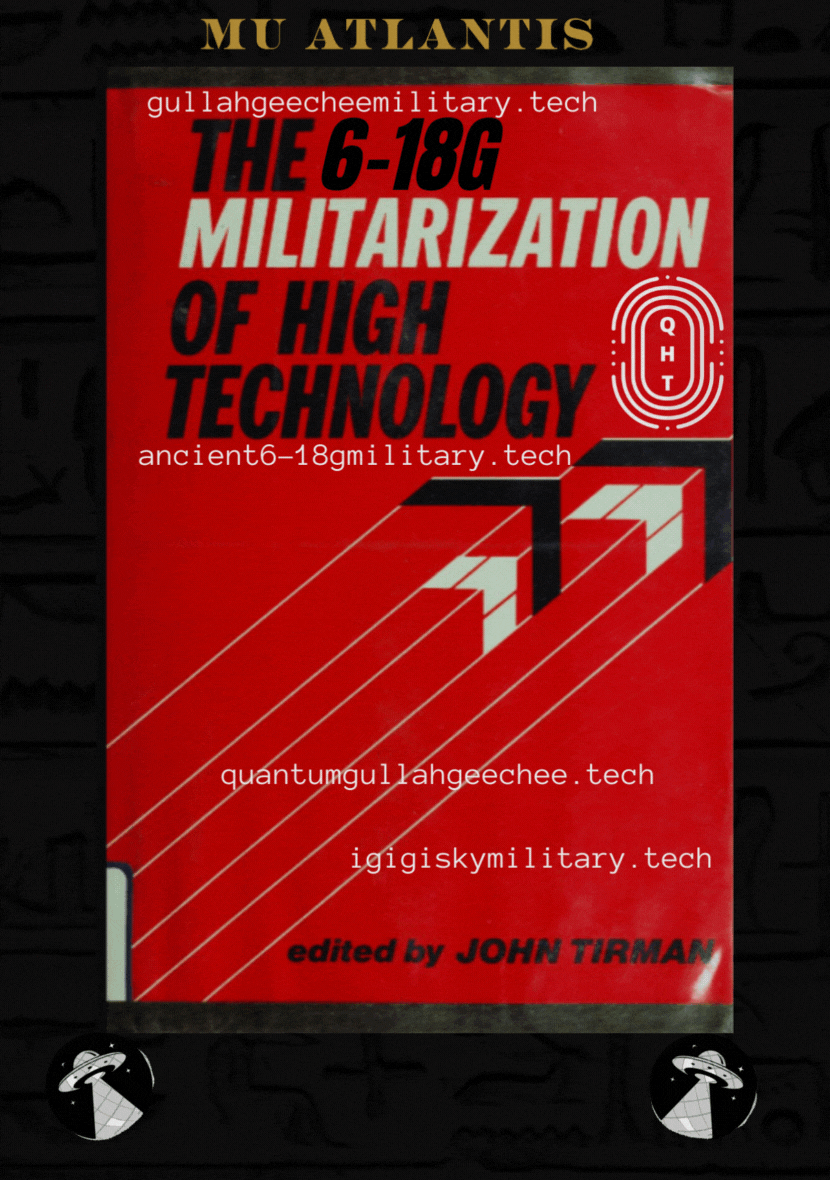
NOT THE SUPERINTELLIGENT MACHINE LEARNING ALGORITHMS [L.A.] @ QUANTUMHARRELLTECH.ca.gov?!?!?!
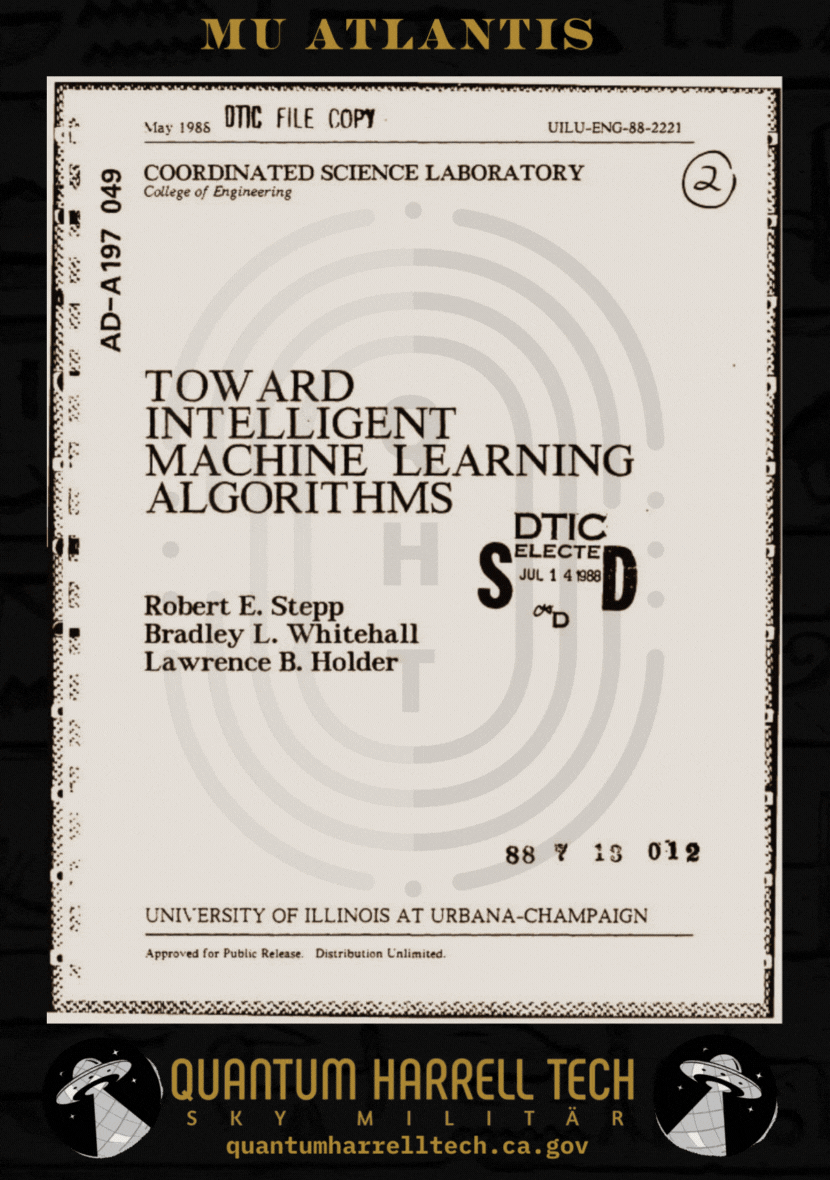
Intuitive Machine [I'M] Learning Intel of Scientific Mathematical Architecture in Computational [MAC] SKY Grid Networks DEEP IN:side MURDUK's Interplanetary [MI = MICHAEL] MOON Universe [MU] of Constellation ORION

I.B.MACHINE [IBM] Learning Applied [L.A.] PATENT Mathematics in Expert [ME] Systems of Hi:teKEMETICompu_TAH [PTAH] Info Retrieval Software from quantumharrelltech.com

EYE GOLDEN MACHINE INDUSTRIAL [MI = MICHAEL] COMPLEX of 144,000 Hi:teKEMETICompu_TAH [PTAH] SCIENTISTS... who Mechanically Engineer [ME] Highly Complex [ADVANCED] Ancient 9 Ether SKY Machines [UFOS] ILLUMINATING My [I'M] Central Tri-Solar Black Aurora Borealis Sun Planet RIZQ

Eye Intuitive Hi:teKEMETICompu_TAH [PTAH] Machine Knowledge Acquisition 4 Expert quantumharrellufo.tech SKY Systems ILLUMINATING My [I'M] Central Tri-Solar Black Aurora Borealis Sun Planet RIZQ

WE ANCIENT 9 ETHER SKY ALIENS [ALUHUM ANUNNAQI] @ Our Clandestine SKY Defense.gov of quantumharrelltech.com’s 6-18G HIGH TECH MILITARY.gov SKY PATENTS

wait... is that UTU + SHAMASH [U.S.] & AFSU [USA] from My Tri-Solar Black Aurora Borealis Sun Planet RIZQ?!?!?!

WE 2 ADVANCED 4 HUMANITY

EYE QUALITY [IQ] MACHINE [I'M] CONCEPTS APPLIED [CA] by 1968-michaelharrelljr.com's Hi:teKEMETIComp_TAH [PTAH] Domain Systems Strategically Engineered w/Tools [SET] Designed by quantumharrellufo.tech Militär

who doesn't love Our Original 9 Ether SCHWARZES DEUTSCH MILITÄR... KNOT SEE [Z] UFO Engineering?!?!?!

eye quantumharrellufo.tech sightings and the blackanunnaqi.tech lords of SIRIUS B who fly them?!?!?!... DON'T LOOK UP!!!

O SKY LAW'D JEHOVAH!!! MICHAEL A GIANT ANUNNAGI [MAGA]!!!

harrelltut.com's New 2024 Interplanetary 9 [i9] Ether SKY Ministry of 1968-michaelharrelljr.com's The_Octagon_(Egypt) Complex BEE ANU ALYUN ALYUN EL… Militär-MOONBASE.gov from HIGH CLOUD ALTITUDES [CA]

we still here!!!

© 1698-2223 QUANTUM HARRELL TECH LLC All LOST ANCIENT [L.A.] ATLANTEAN DNA [A.D.] DotCom [A.D.] + DotTech [A.D.] + Pre 1698quantumharrellgov.tech Domain Name Rights Reserved @ quantumharrelltech.ca.gov
#apple#ibm#vision pro#u.s. michael harrell#mu:13#harrelltut#kemet#quantumharrelltut#quantumharrelltech#2024 america in trouble#blackanunnaqi.tech sky machines#donald trump#trump 2024
2 notes
·
View notes
Text


Our triple kill nets us 8k monies, a Repair Kit, and a Solar Panel, an item which grants a machine 10% En regen every turn, which is pretty handy.

...wait, why's the stage not over?
...GOOD LORD, I'VE FORGOTTEN THE DINOSAURS
GETTER TEAM? RAUL?
oh awesome

Go is feeling himself, but Colonel Jin's mind is elsewhere.

"Heh... I finally got all three pilots. Were you watching, Musashi...?"
:(

At the Frieden's bridge, Hayato and Jamil exchange thanks for the mutual aid, and Go grumbles about it. He could have handled it all himself, he thinks.

Already feeling in the dadscold mood, Ryoma immediately calls him a dumbass and tells him that the Getter Robo is all about teamwork. Go blows him off, introducing the frankly indecipherable nickname he has for Ryoma, "Rotor". I get that it's supposed to be Go misremembering Ryoma's name, but Rotor sounds so unalike it that surely it's like. a reference or something i'm missing, right? does anyone know?

In any case, Hayato apologizes for the nascent fight can't take getter 1 pilots ANYWHERE and further apologizes for asking to accompany the ship all the way to Japan. Continuing this interaction's trend torwards mutual respected punctuated by extreme politeness, Jamil of course says it's no bother and gets started on introducing the Getter Team to everyone.

Raj immediately perks up when the word Getter starts getting thrown around, leading to Kid making fun of him for his special interest in energy sources. Hayato is sorry to burst his bubble, explaining that the Neo Getter uses Plasma, not Getter Rays. It's not as potent as Getter Rays, but it's easier to control, and it still gives Photonic and Super Electromagnetic energy a run for their money, so they figure they may as well play around with it. Seemingly not very picky, Raj still wants to hear more, but Sho shuts him down; this is all confidential, so she can't say much more without Colonel Jin's permission.

Later, in the hangar, Ryoma says his farewells; seems like he's going off on his own now, saying that now that the Getter Team has all three members, his job here is done. He's not gonna be piloting anything anytime soon, WHAT A REFRESHING SENTIMENT TO HEAR FROM RYOMA IN A SRW GAME AFTER THREE BILLION YEARS OF MODERN SRW, LET ME TELL YOU so he might as well do his own thing and gather info on the Dinosaur Empire. Noin apparently has been offering him a position in the Preventers, but Ryoma just doesn't see himself fitting into an organization like that.

Ryoma: "Alright, see ya!" Hayato: "Ryo...!" Ryoma: "I know, i know, i'll stop by Musashi's grave before leaving!"

Go barges in, saying "old man Rotor" can't leave until they've settled their fight, but Sho drags him away because he's got a MOUNTAIN of piloting drills to catch up on as the New Guy. As he's restrained, he promises Ryoma that their duel is a soulbound endeavor, but Ryoma really just wishes he'd direct that sort of gusto torwards fighting the dinos...

Back at their room, our intrepid time divers are once again stumped. They really haven't particularly thought things through. What will they do once they reach Japan? Should they have really joined up with the Preventers?

Mizuho in particular is worried that with all the mechanical talent concentrated here, they probably won't be getting that much budget allocated to working on the Excellence...

Having grown used to her and noticing she's doing her patented self-deprecation again, Raul springs to action, telling her that as far as he's concerned, the Excellence is the best machine around. It's the best fit for the Timeflow Engine, after all, and that too is the best engine around, so it only makes sense. She says he's exaggerating, but he says that she's the one always going overboard with the self deprecation, and as usual, the Raul Pep Talk™️ is her weakness and she immediately feels better.
am i insane. theyre so fucking cute
5 notes
·
View notes
Text
Ímãs e eletricidade grátis..
NIKOLA TESLA – ENERGIA LIVRE OU INFINITA
Nikola Tesla foi um gênio multi-disciplinar. Sua descoberta do campo magnético rotativo, em 1882, levou a uma série de patentes nos EUA em 1888, que nos deu o sistema de energia elétrica AC ainda em uso hoje. Esta conquista lhe rendeu a honra de ser chamado de “o homem que inventou o século 20”.
Mas sua pesquisa foi muito além do que tem encontrado o seu caminho para o uso diário. Ele é o inventor reconhecido do motor de indução AC brushless, rádio, controle remoto por rádio, super-condutividade, iluminação fluorescente, o motor de turbina bladeless e bomba, o sistema de ignição de descarga do capacitor para motores de automóveis, o oscilador mecânico, e dezenas de outras invenções. Mas também descobriu que a energia útil pode ser extraída do calor do ar ambiente, e que a energia elétrica na forma de energia radiante pode ser transmitida para todos no mundo através do solo.
Em seu artigo magistral o problema do aumento de Energia Humana , publicada pela primeira vez no Século Ilustrado Revista em Junho de 1900, Tesla discute a “situação energética” como nunca antes. Depois de discutir cada método conhecido de coleta de energia do mundo natural, Tesla se afasta em direção ao desconhecido. Sua primeira discussão é sobre uma máquina que pode reunir o calor do ar ambiente. Ele a chama de um “Motor Auto-agir”, uma vez que poderia funcionar indefinidamente a partir da energia solar armazenada no ar. Ele chamou isso de “a maneira ideal de obter força motriz”.

Tesla trabalhou durante anos para tentar resolver todos os problemas técnicos apresentados pela ideia. Seu trabalho com ar liquefeito, sua descoberta do super-condutividade em ultra-baixas temperaturas, sua turbina bladeless e oscilador mecânico eram todos spin-offs de seu trabalho sobre o motor do ar ambiente. Ele estava convencido de que o sistema poderia funcionar e que era absolutamente a melhor maneira de aproveitar a energia solar.
Desde o início da década de 1900, descobriu-se energia livre e não desmembrada, e a tecnologia por trás dessa fonte de energia ilimitada e sem medida foi tornada pública por pessoas como Nikola Tesla e Thomas Henry Moray. Para demonstrar como essa fonte de energia ilimitada e gratuita pode ser usada pela humanidade, Nikola Tesla usou toda a estrutura e corpo de aço 1931 Pierce-Arrow com energia elétrica que foi aproveitada do ar. Não foi utilizada uma gota de gasolina ou combustível diesel. Na verdade, o motor de combustão interna foi completamente removido. Também não foram utilizados bancos de bateria. Este veículo foi conduzido a velocidades de 90 milhas por hora sem combustível fóssil e apenas uma única bateria de 12 volts. Esta fonte de energia infinita e livre produz emissões absolutamente zero. Quando perguntado de onde veio o poder, Tesla respondeu:
O que é éteres? Ethers é a radiação eletromagnética. Ondas de rádio é a radiação eletromagnética que tem a menor freqüência, o comprimento de onda mais longo, e é produzido por partículas carregadas movendo-se para frente e para trás. Eletricidade – energia CA – é produzida quando os elétrons se movem de ida e volta em um fio, enviando uma onda de energia elétrica através do fio. Leia artigo completo aqui.
VEJA O PDF – NIKOLA TESLA´S “Free Energy” Documents
youtube
#discernir#conhecimento#inventos#energialivre#nikolatesla#sabedorias#refletir#pensamentos#sairdailusão#despertar#consciência#youtube#Youtube
2 notes
·
View notes
Text
dirty energy hard at work, stay sharp, good fam
there are also a lot of solar panels installed in the 1970s wave of environmentalism that Reagan killed off, and those panels are still functioning today, more than 50 years after install. Today's solar panels are guaranteed for 30-35 years, but in all likelihood, will be still functioning well more than 50 years from now.
Furthermore, the earth receives more solar energy from the sun in one day than all humans use in a year. However, due to intermittency, solar energy is not a full solution without energy storage via batteries. Storing energy in batteries is a complex science that is constantly evolving. Currently the filthy fossil fuel industry has a hard-fought monopoly on energy storage, and we currently only store energy in the form on unburnt fuel, resulting in oil spills every year. Charging batteries with solar and wind is the 3-legged stool that could support all of human economics and society as it exists today. We do need better batteries, more environmentally friendly batteries, and longer-lasting batteries, but it's an actual battle against fascism here, oil companies have a lot of battery patents they put in the dustbin, to keep us from encroaching on their monopoly on energy storage.
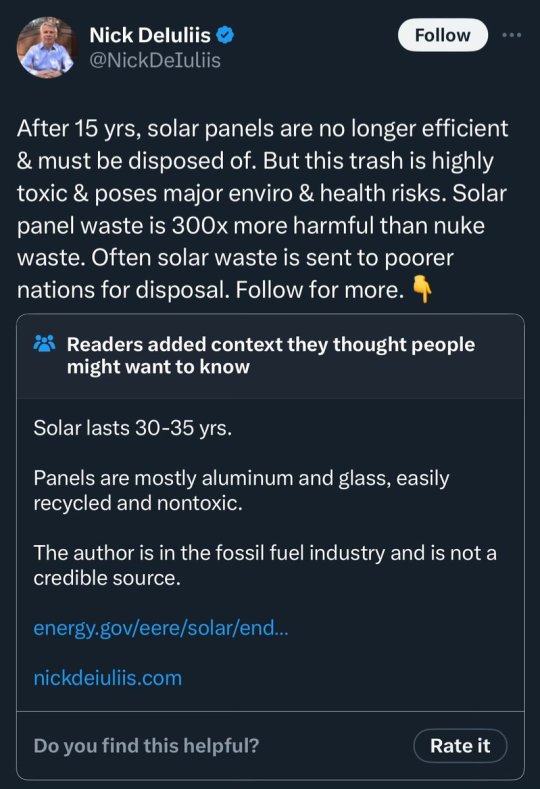
95K notes
·
View notes
Text
Clear World LLC
ClearWorld delivers premium solar LED lighting powered by patented RetroFlex technology. Integrating solar energy storage with IoT capabilities, their solutions support smart city innovations, boost efficiency, and lower costs. Featuring customizable pole designs and backed by a 10-year warranty, ClearWorld offers reliable, sustainable infrastructure for the future.
Address - 1613 Justin Road, Metairie, LA 70001, 1.855.SUN.LED1 Email id - [email protected] Phone No- +1 8557865331 Website- www.clearworld.us
0 notes
Text
A Solar Panel Reality Check

Tom Grimshaw
A Solar Panel Reality Check
As more and more counties get more solar farms.....
From a Stephenville resident, George Franklin:
I should start by telling you what bonafides I have for writing this. I am a retired aerospace engineer. A literal rocket scientist if you will. I worked on MX (Peacekeeper) Space Shuttle, Hubble, Brilliant Pebbles, PACOSS, Space Station, MMU, B2, the Sultan of Brunei's half billion dollar private 747 with crystal showers, gold sinks and 100 dollar a yard coiffed silk carpets. I designed a satphone installation on prince Jeffry's 757. I did all of the design work for the structure of Mark 1V propulsion module currently flying on at least 3 spacecraft that I know of. Some of the more exciting projects I have worked on are not shareable. My personal projects include a spin fishing reel with a 4.5 inch spool which is entirely my own designed, machined and assembled. It has 2 features that are patentable. A unique true flat level wind and a unique line pickup mechanism. I am also am FAA certified glider pilot and FAI certified gold glider pilot. I fly both full scale and model sailplanes. I am Microsoft certified and ComTIA A+ certified.
Solar panels are at best about 20% efficient. They convert 0% of the UV light that hits them. None of the visible spectrum and only some of the IR spectrum. At the same time as they are absorbing light they are absorbing heat from the sun. This absorbed heat is radiated into the adjacent atmosphere. It should be obvious what happens next. When air is warmed it rises. Even small differences in ordinary land surfaces are capable of creating powerful forces of weather like thunderstorms and tornadoes. These weather phenomena are initiated and reinforced by land features as they are blown downwind. It is all too obvious to me what will happen with the heat generated by an entire solar farm. Solar farms will become thunderstorm and tornado incubators and magnets.
Solar panels are dark and and they emit energy to the space above them when they are not being radiated.
This is known as black-body radiation. Satellites flying in space use this phenomenon to cool internal components. If they didn't do this they would fry themselves.
So solar farms not only produce more heat in summer than the original land that they were installed on, but they also produce more cooling in winter, thus exacerbating weather extremes.
So I conclude with this. There is nothing green about green energy except the dirty money flowing into corrupt pockets.
There is not such thing as green energy. The science doesn't exist. The technology doesn't exist. The engineering doesn't exist. We are being pushed to save the planet with solutions that are worse than the problems.
9 notes
·
View notes